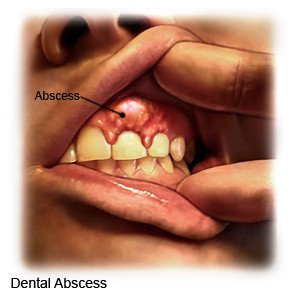Dental Abscess
Medically reviewed by Drugs.com. Last updated on Aug 4, 2025.
AMBULATORY CARE:
A dental abscess
is a collection of pus in or around a tooth. A dental abscess is caused by bacteria. The bacteria can enter the tooth when the enamel (outer part of the tooth) is damaged by tooth decay. Bacteria can also enter the tooth through a chip in the tooth or a cut in the gum. Food particles that are stuck between the teeth for a long time may also lead to an abscess.
 |
Common signs and symptoms:
- Toothache, a loose tooth, or a tooth that is very sensitive to pressure or temperature
- Bad breath, unpleasant taste, and drooling
- Fever
- Pain, redness, and swelling of the gums, or swelling of your face and neck
- Pain when you open or close your mouth
- Trouble opening your mouth
Seek care immediately if:
- You have severe pain in your tooth or jaw.
- You have trouble breathing because of pain or swelling.
Call your doctor if:
- Your symptoms get worse, even after treatment.
- Your mouth is bleeding.
- You cannot eat or drink because of pain or swelling.
- Your abscess returns.
- You have an injury that causes a crack in your tooth.
- You have questions or concerns about your condition or care.
Treatment:
You may need any of the following:
- Medicines may be given to treat a bacterial infection and decrease pain.
- Incision and drainage is a cut in the abscess to allow the pus to drain. A sample of fluid may be collected from your abscess. The fluid is sent to a lab and tested for bacteria. Ask your healthcare provider for more information.
- A root canal is a procedure to remove the bacteria and prevent more infection. It is usually done after an incision and drainage. A filling or crown will be placed over the tooth after you have healed from your root canal.
- Tooth removal may be needed if the infection affects deeper tissues. This is usually done after an incision and drainage.
Treatment options
The following list of medications are related to or used in the treatment of this condition.
Self-care:
- Rinse your mouth every 2 hours with salt water. This will help keep the area clean.
- Gently brush your teeth twice a day with a soft tooth brush. This will help keep the area clean.
- Eat soft foods as directed. Soft foods may cause less pain. Examples include applesauce, yogurt, and cooked pasta. Ask your healthcare provider how long to follow this instruction.
- Apply a warm compress to your tooth or gum. Use a cotton ball or gauze soaked in warm water. Remove the compress in 10 minutes or when it becomes cool. Repeat 3 times a day.
Prevent another abscess:
- Brush your teeth at least 2 times a day with fluoride toothpaste.
- Use dental floss at least once a day to clean between your teeth.
- Rinse your mouth with water or mouthwash after meals and snacks. Chew sugarless gum.
- Avoid sugary and starchy food that can stick between your teeth. Limit drinks high in sugar, such as soda or fruit juice.
- See your dentist every 6 months for dental cleanings and oral exams.
Follow up with your doctor or dentist as directed:
Your healthcare provider will need to check your teeth and gums. Write down your questions so you remember to ask them during your visits.
© Copyright Merative 2025 Information is for End User's use only and may not be sold, redistributed or otherwise used for commercial purposes.
The above information is an educational aid only. It is not intended as medical advice for individual conditions or treatments. Talk to your doctor, nurse or pharmacist before following any medical regimen to see if it is safe and effective for you.
Learn more about Dental Abscess
Treatment options
Care guides
Medicine.com guides (external)
Further information
Always consult your healthcare provider to ensure the information displayed on this page applies to your personal circumstances.
